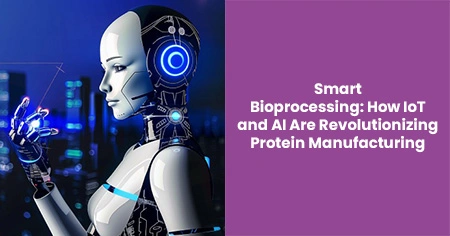In a traditional biomanufacturing setting, maintaining the correct OTR meant meticulous adjustments and constant monitoring, often with significant lag between cause and effect. With today's digital tools, that dynamic has changed. Data is now being captured, processed, and acted upon in real-time, allowing for greater precision and fewer disruptions. This shift from reactive to proactive bioprocess management is redefining industry benchmarks.
Why Oxygen Transfer Rate Still Matters
The oxygen transfer rate (OTR) directly influences protein yield by affecting cell metabolism and viability. Most mammalian and microbial cell cultures have particular oxygen requirements. For instance, Chinese Hamster Ovary (CHO) cells typically operate best at OTRs ranging between 150–200 mmol O2/L/h, while bacterial strains like E. coli can tolerate OTRs upwards of 500 mmol O2/L/h.
Insufficient oxygen levels lead to cellular stress, reduced growth, and compromised protein folding. On the other hand, excessive aeration can cause shear stress, damaging cells and reducing yields. Striking the right balance is vital to ensure both cell health and productivity, particularly in large-scale production where inconsistencies have significant cost implications.
Traditionally, achieving optimal OTR has involved trial and error, manual control, and highly skilled technicians. However, such manual systems are often unscalable and prone to inefficiencies. That’s where intelligent, software-powered systems come into play.
Smart Sensors and IoT-Enabled Bioreactors
Today's bioreactor systems are embedded with optical dissolved oxygen (DO) sensors, scalable IoT devices, and cloud-based dashboards. These tools allow teams to:
- Monitor OTR and dissolved oxygen (DO) in real-time across multiple units
- Receive alerts for suboptimal conditions
- Leverage historical data to fine-tune production batches
- Generate performance reports to comply with regulatory frameworks like cGMP and FDA 21 CFR Part 11
One key benefit of IoT in biomanufacturing is centralized data accessibility. Engineers, quality teams, and plant operators can log in from different locations and analyze live metrics, enabling a coordinated response to deviations and reducing downtime.
These systems are particularly advantageous during scale-up. In traditional setups, translating lab-scale oxygen requirements to industrial volumes can result in significant loss of efficiency due to changing hydrodynamic behavior. Smart bioreactors can simulate and automatically compensate for such variables in real-time.
AI and Predictive Analytics: Beyond Manual Control
With AI algorithms, bioreactor control systems can now:
- Predict oxygen demand based on cell growth patterns
- Automatically adjust aeration and agitation to maintain optimal OTR
- Identify inefficiencies or risks before they impact yield
- Balance OTR with other critical parameters such as pH, temperature, and nutrient availability
AI doesn’t just optimize the current batch — it learns from previous runs. This continuous feedback loop enhances predictive accuracy, allowing systems to respond before problems occur. Machine learning models can also detect subtle anomalies that human operators might overlook, leading to better batch consistency and reduced wastage.
Some companies are even integrating Natural Language Processing (NLP) interfaces into their control platforms, allowing operators to query systems conversationally: "What was the average OTR in the last 24 hours?" or "Why was DO lower in tank 3 compared to tank 1?"
From CFD Modeling to Digital Twins
Modern biotech facilities also use computational fluid dynamics (CFD) and digital twin technologies to model and simulate bioreactor environments. These tools allow engineers to:
- Mass transfer challenges during scale-up, such as how to visualize oxygen gradients and flow patterns
- Advanced modeling techniques help predict how changes in vessel design or impeller geometry affect OTR
- Design systems optimized for specific cell lines or proteins
Digital twins — virtual replicas of physical bioreactors — update in real-time based on sensor input. These models allow simulations to reflect current operating conditions, making them powerful tools for training, optimization, and troubleshooting. Engineers can use digital twins to conduct virtual experiments before making real-world changes, reducing risk and improving agility.
CFD, on the other hand, plays a crucial role in process development by analyzing gas-liquid interactions, identifying dead zones, and helping to fine-tune sparger design. Together, CFD and digital twins provide a synergistic approach to smarter bioprocessing.
Business Benefits: More Than Just Better Biology
By incorporating smart technologies into protein manufacturing, biotech companies realize several business advantages:
- Reduced Failure Rates: Real-time monitoring minimizes batch losses due to OTR-related issues
- Lower Costs: Automation reduces manual oversight and optimizes resource use
- Faster Scale-Up: Data-rich environments make it easier to transition from lab to pilot to full-scale production
- Improved Regulatory Compliance: Automated documentation and real-time traceability improve audit readiness
- Data-Driven Decision Making: Real-time KPIs and analytics dashboards allow for better resource allocation
These benefits extend beyond the production floor. With integrated Enterprise Resource Planning (ERP) and Manufacturing Execution Systems (MES), data from bioreactors can inform strategic planning, demand forecasting, and quality assurance.
Cross-Industry Parallels: Lessons from Smart Manufacturing
The evolution of smart bioprocessing mirrors trends in other industries. Automotive, aerospace, and electronics manufacturers have already adopted IoT and AI to improve production line efficiency, reduce defects, and enable mass customization.
Biotech is now following suit. The challenges may differ — biological variability vs. mechanical tolerances — but the solutions are converging. Smart sensors, data integration, and AI modeling are now seen as essential infrastructure, not optional add-ons.
By viewing biomanufacturing as part of the broader Industry 4.0 movement, biotech leaders can draw insights from more mature sectors and accelerate their own digital transformation journeys.
Workforce Enablement in the Age of Smart Bioprocessing
As biomanufacturing systems become more intelligent, the role of human operators is also evolving. No longer just technicians, operators now need to be data interpreters, systems analysts, and digital troubleshooters.
Biotech companies are beginning to:
- Upskill employees with data science and AI literacy programs
- Integrate augmented reality (AR) tools for hands-on training
- Utilize virtual reality (VR) simulations for bioreactor handling
This digital shift doesn’t eliminate the need for human expertise; rather, it enhances it. Human judgment, paired with AI-assisted insights, results in smarter decision-making across the board.
Sustainability and Energy Efficiency Through Digital Optimization
One of the lesser-discussed but increasingly vital aspects of smart bioprocessing is its contribution to environmental sustainability. Efficient OTR control reduces wasted oxygen, minimizes energy consumption from agitation and sparging, and cuts down on cooling requirements.
AI systems can:
- Optimize energy use dynamically based on real-time cell demand
- Schedule maintenance to prevent energy spikes from equipment failure
- Reduce raw material waste by maintaining precise culture conditions
For biotech firms aiming to meet environmental, social, and governance (ESG) goals, smart manufacturing offers a path to greener, more efficient production.
The Role of Cloud Platforms and Edge Computing
Cloud computing has enabled the aggregation of bioprocessing data across facilities and geographies. Data lakes, machine learning platforms, and integrated dashboards allow centralized control over decentralized operations.
Edge computing complements this by allowing time-sensitive decisions to be made locally. For example:
- Edge devices can control local OTR levels in milliseconds
- Critical alerts can be processed on-site without latency
- Redundant control layers can prevent downtime during cloud disruptions
Together, cloud and edge technologies make smart bioprocessing resilient, fast, and scalable.
Building a Roadmap to Smart Bioprocessing Adoption
Transitioning to smart bioprocessing doesn’t have to be overwhelming. Organizations can adopt a phased approach:
- Assessment: Analyze current bottlenecks and technology gaps
- Pilot Projects: Implement smart bioreactors or AI tools at a small scale
- Integration: Connect platforms with ERP, MES, and quality systems
- Scale-Up: Expand successful pilots across production lines and sites
- Continuous Improvement: Use analytics for ongoing optimization
Vendor partnerships, government grants, and cross-functional teams can accelerate this transformation, helping organizations move confidently into a future where biotech and technology are fully integrated.
The Future: AI-Driven, Fully Connected Biomanufacturing
Looking ahead, smart bioprocessing will only become more intelligent and autonomous. Future systems may integrate:
- AI models trained on multi-batch datasets
- Fully cloud-controlled bioreactors accessible from mobile devices
- Blockchain for secure batch traceability
- Voice-activated interfaces or AR-assisted maintenance tools
- Cross-site data harmonization for multi-facility enterprises
Imagine a world where bioreactor conditions can be optimized from a smartwatch or where a machine learning model alerts you to a minor change in pH that will impact yield two days later. That future is already taking shape in cutting-edge facilities around the world.
Final Thoughts
For companies operating at the intersection of biology and technology, the evolution of bioreactor systems into IoT- and AI-powered platforms represents a significant leap forward. These aren't just tools for scientists — they're strategic assets for modern businesses.
The convergence of biotechnology and business technology is reshaping protein manufacturing from the ground up. It’s no longer about simply meeting production targets; it's about building a resilient, intelligent, and agile manufacturing ecosystem.








